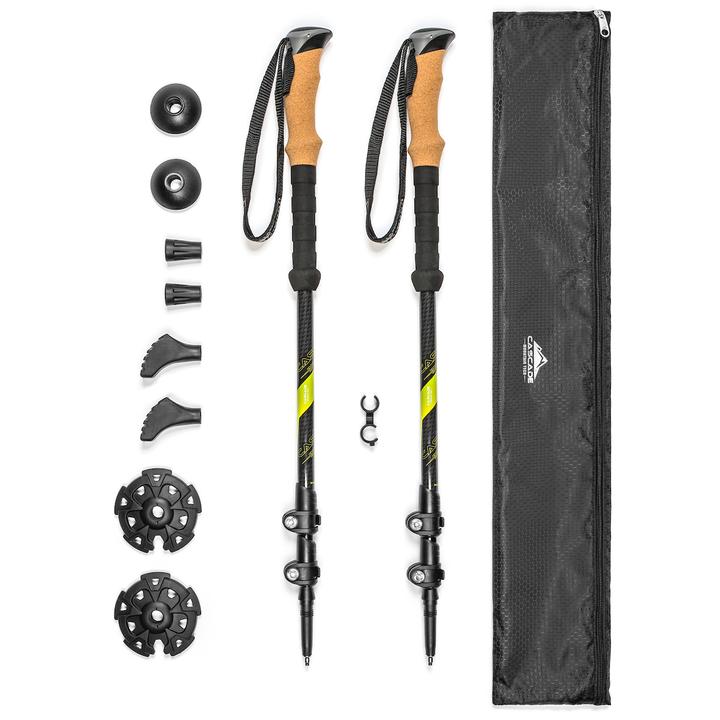S&S Archery Trekking Poles: Worth The Weight?
Giving them a Shot
Well, a couple years ago I was convinced by a friend to give them a try on some hikes to see what I thought. Over the last few years my opinion changed. While I don’t think they are necessary or even practical in all situations, I’ve found that they are absolutely a difference maker when it counts.
Using trekking poles also allows you to use many other shelters that integrate trekking poles in place of standard tent poles. This gives you access to some of the best shelters on the market that you may not have considered before. Stay tuned for my full review on some of those trekking pole tent options.
What are some Trekking Pole options?
Decided to give trekking poles a try? Looking at replacing what you have or making a change to something a bit lighter? What are the options? Are the twist-lock or lever-lock legs better? Is there a benefit to carbon over aluminum? Why are some handles cork vs a foam material? I’ll answer some of those questions here.
Cascade Mountain Trekking Poles (Costco Trekking Poles)
When I decided to give trekking poles a try, I grabbed a pair of the Cascade Mountain Carbon Trekking Poles. At only $45.00 for the pair and only 8 ounces each, I figured it was a great place to start to see if I even liked trekking poles. They served me well and held up fine especially for the price.
S&S Archery Trekking Poles
Over this last summer and fall I was also able to put the S&S Archery trekking poles through the rigors of the backcountry. Both sets of poles are very lightweight, functional, and do what they are designed to do.
Now, I know there are many other brands and models of great trekking poles out on the market today, but for the purpose of this review, I wanted to highlight the the two primary styles you will likely encounter.
Trekking Poles Review: Best Materials
Carbon vs. Aluminum
The two primary materials you’ll find when looking at trekking poles are carbon and aluminum. Generally speaking, aluminum poles are going to be less expensive but significantly heavier. Aluminum poles are also much more susceptible to bending than carbon. As you can imagine, carbon is typically the preferred material due to its strength to weight ratio as well as long term durability. There are certainly some great aluminum trekking poles on the market though.
Trekking Pole Grip: Cork vs. Foam
The grip material can be a huge factor in comfort when pushing yourself up that steep mountain or stabilizing yourself with a heavy load when you have sweaty palms. It’s easy to overlook, but for most of us, the palms of our hands also perspire to some degree under high exertion. This can cause some discomfort if the grip handle isn’t made well.
I’ve found both foam and cork handles to be very comfortable, with the durability edge going to foam. A benefit of cork is that it will take on the shape of your hand over time, which can make it more comfortable. The downside is that cork is more susceptible to deterioration while EVA Foam will maintain its shape during its lifespan. I found that the cork handle of the Cascade Mountain Trekking Poles degraded more quickly with use. Cork isn’t as durable of a material as EVA Foam and seemed more susceptible to chip or peel, etc. I found that I preferred the foam grip for its durability, but both styles do a great job.
Locking Systems: Twist-Lock vs. Lever-Lock
The two primary locking systems you’ll find are twist-locks and lever-locks. I know some poles offer push button locking mechanisms, but I wasn’t able to test any of that style. The type of locking mechanism comes down to personal preference, although there are some benefits to each. Lever-locks are simple and easy to use. They do, however, add some weight and bulk to the poles.
I preferred the lever-lock initially because the twist-locks on the set of REI Aluminum poles I was using seemed to constantly untwist. It wasn’t until I used the S&S Archery Carbon Lite poles with the twist-lock that I came to love that style. A quality twist-lock system like the S&S Archery poles saves weight, bulk, and has less to snag on when pulling them in and out of your pack.
Best Uses of Trekking Poles
The beauty and challenge of refining your gear setup is finding items that have multiple uses. High quality trekking poles are one of those items. If you are a trekking pole user, consider using them as your shelter poles to reduce your shelter weight. Many of the shelters in my Backpacking Tent Review give you the option of using trekking poles.
So, when do I bring them? Well, I found that trekking poles were cumbersome in terrain with tall, bushy vegetation. I also found myself leaving them at camp if I knew I wouldn’t have a difficult pack out if I were to get an animal down. But as soon as you try to predict that, you’ll inevitably end up wishing you had them with when that bull or buck you shoot runs down into the deepest, darkest hole around.
I always take them on backpack trips, and especially when solo and/or when I know the area I’m hunting might produce a long, steep or rugged pack out. If I know I’m hiking deep into the backcountry and hunting by myself with a chance of coming out heavy, there is absolutely no question. They are coming with me.
Cascade Mountain Trekking Poles
These Cascade Mountain trekking poles were my introduction to the trekking pole world. With a price tag of just $45 for a pair of these carbon fiber Cascade Mountain trekking poles, these are a perfect way to dive in and see if you want to join the trekking pole world. While these poles don’t feature the highest quality materials, they will definitely get the job done. The cork handles are very comfortable, the lever-lock system works well, and they come with an assortment of rubber tips and snow/sand baskets.
The areas where the quality is a bit on the Cascade Mountain trekking poles lower starts with the lever system. While it functions just fine, the nut that allows you to adjust the lever is made of plastic. While I never personally had an issue with this breaking in the two years I used them, being plastic, it,s just a matter of time before it fails. An easy way to negate that is to replace the plastic nut with a steel one from the hardware store. The few cents is well worth it to ensure your trekking pole doesn’t become useless, dead-weight in the backcountry.
Cascade Mountain Trekking Poles: Features
Some of the features of the Cascade Mountain Tech Trekking Poles are:
3 section lever-lock
Lightweight ( 8oz each)
Cork grip
Carbide Tip
Lots of rubber tip options with both sand and snow baskets included
Cascade Mountain Trekking Poles: Pros and Cons
The handles on these poles are made of cork, which helps lower the cost. One thing I found odd on the Cascade Mountain trekking poles was the extension of the handle down the pole. The cork turned to a foam material at this point, but in my opinion, this extra foam just adds unnecessary weight. Finally, and really my primary complaint with the Cascade Mountain trekking poles was that there was a slight “buzz” in the pole when it is planted firmly in the ground. It seemed to be coming from the extension pieces vibrating together. It wasn’t that big of a deal, but no matter how much I tightened down the lever-lock, I couldn’t get rid of it.
All in all, these Cascade Mountain trekking poles are a heck of a deal. Typically, when you enter the world of carbon trekking poles, you’ll anticipate spending over $100. These poles allow you to have a great carbon pole for a fraction of the cost.
s&S Archery Trekking Poles
Coming in at only 6.3 ounces each, they feel so lightweight you almost question the build quality. I can tell you with certainty, however, that these things are built like a rock. While packing out my elk this year, a minor stumble with the weight of my 100+ pound pack forced me to wedge my pole between two rocks for balance as I was slipping through a rocky hillside. I thought the pole might snap, but it came out unscathed. Better yet, the pole saved me from a painful fall with a heavy load.
Features Of S&S Archery Trekking Poles
Some of the features of the S&S Archery trekking poles include:
3 section twist-lock
High quality carbon
Super lightweight (6.3oz each)
EVA foam grip
High quality, nice soft wrist straps
Carbide tip
The S&S Archery Trekking Poles also come with a rubber foot and a sand/snow basket attachment and compress down to a measly 26 inches. The length is easily adjustable with the simple twist of each section. To be honest, coming from a lever-lock system, I wasn’t excited about the twist-lock. The other twist-lock poles seemed to untwist at the worst possible times, sending me stumbling, trying to catch my balance. These, however performed flawlessly. In fact, I came to like the twist-lock system better than the lever-lock. I found that they were less bulky and had fewer things to hang up on your pack when pulling them out or putting them away.
I found the handles to be very comfortable and they never gave me hot spots or blisters. The straps are made of a super soft material that was very comfortable.
S&S Archery Trekking Poles: Pros and Cons
All in all, these S&S Archery CL Backcountry trekking poles were nothing short of awesome. What would I change about these poles? I honestly can’t think of anything other than the price tag. It would be nice to have the ability to convert your trekking poles to a monopod to set your binos on and glass, but that just adds weight. There are trekking poles out there designed to be a two or three in one system (trekking pole/gun rest/monopod), but that is clearly not the purpose behind these poles.
These are designed to be ultralight, ultra-tough, and backcountry friendly. Yeah, I get it. Dropping $145.00 on trekking poles doesn’t sound all that fun, but you get what you pay for in quality, durability, and some of the lightest poles you can find. Relative to other poles of this caliber on the market, it’d be tough to find anything of better quality and design at this price.
Conclusion
At the end of the day, whether or not you use trekking poles largely depends on your style of hunting, the gear you use, and terrain you hunt. For me, trekking poles have become an item that are usually with me. I use them now with my tents, for those steep climbs and descents, and most importantly, when coming out heavy. Don’t take my word for it though. Grab a pair and give them a try. I don’t think you’ll be disappointed.
A huge thank you to S&S Archery for providing me with the opportunity to test out the S&S Archery Trekking Poles for this review.
Subscribe to Backwoods Pursuit to get our FREE Backcountry Gear Worksheet!!!
Dial in your gear list, calculate your pack weight, and lighten up your pack with this handy tool!










